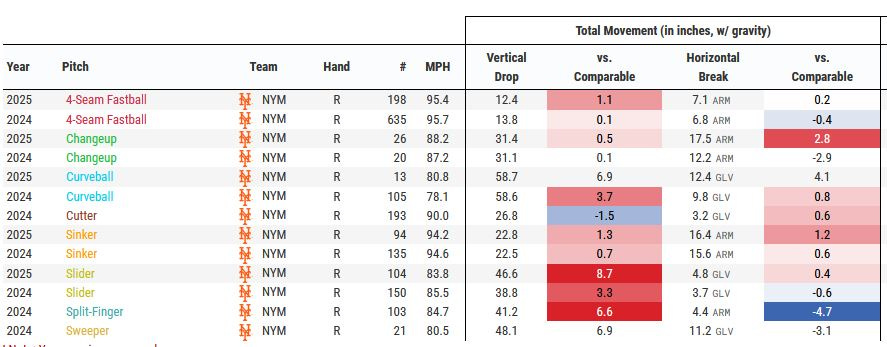It’s certainly been a start to the season hasn’t it? The Mets not only sit in first place atop the National League East, with five full games separating them and the second-place Phillies, their 19-8 record is the best in baseball. They’ve allowed the fewest runs in the league, and their rotation and bullpen have been no less than dominant in the season’s early going. This is all with Sean Manaea and Frankie Montas on the shelf to start the season, mind you.
Just as they planned it, eh?
The general sentiment was that this Mets team was going to go as far as their lineup propelled them with a big shrug as to whether the pitching staff that David Stearns assembled would be a buoy or anchor on the team’s ultimate ceiling. That hasn’t been the case so far this season, though it feels as though subverting expectations in this manner is an organizational tradition at this point.
At the forefront of this unexpected performance, at least in terms of accumulated value in the rotation, is Tylor Megill with his 1.0 fWAR. Megill was the subject of a recent MLB.com article by Anthony DiComo wherein he highlights the success that Megill is having with his “stuff,” that historically-ambiguous-but-actually-measurable concept that FanGraphs attempts to assess using factors like release point, movement, and spin rate. Megill currently sits near the top of the league per this stat, known as Stuff+, among starters with 20 or more innings so far this season.
More specifically, DiComo notes that Megill has tweaked his arsenal dating back to last summer when his ascent really started. His changeup and curveball have been modified, and he’s put extra emphasis on the usage of his sinker while effectively eliminating the use of his splitter. The breakdown of the Stuff+ ratings for each of his pitches can be found at Fangraphs, and here you can see there’s certainly improvement with his fastball and sinker as well as his curve according to these metrics. FanGraphs also charts the dramatic increase in sinker (9.8% vs 21.6%), changeup (1.5% vs 6%), and slider usage (13.2% vs 23.9%) as well as the decrease in the use of his curve (7.8% and 3%).
He’s getting fewer swinging strikes but more called strikes than last year. Batters are generally swinging less but making more contact when swinging in or out of the zone, and the contact they are making is of the soft and medium variety with nearly triple the infield fly ball percentage and a Barrel rate that’s almost cut in half compared to last season. His strikeout and walk rates have remained relatively consistent compared to last season (which themselves were increases from his career norms), and he’s not given up a single home run. In short, and as the chart below from Baseball Savant illustrates, the quality of contact against him has cratered to his (and the team’s) benefit.
Is his success truly the result of a difference in his “stuff,” or is it more of a refinement and maturation in his approach to hitters? He altered his pitch mix and, theoretically, his decision-making in the way in which he attacks hitters as a result of both the literal changes to the behavior of his pitches as well as a blossoming confidence in his ability. This, again in theory, would mean he’s less predictable now than perhaps he was a year ago in terms of the league understanding what to expect when facing him in a given in-game situation.
But if there were any doubts about an actual change to his “stuff,” just take a look at the differences in both vertical and horizontal movement on his pitches:
The chart above, also courtesy of Baseball Savant, paints a clear picture of a pitcher who indeed has had a dramatic change in what we would deem “stuff” as compared to last season. There’s almost an eight-inch difference in the vertical drop of his slider. How about the horizontal break on his changeup? Some of these differences are, to put it technically, bonkers.
As an aside, though relevant to the next observation, his pace is nearly a second faster this season than it was last year. Taking the changes to how his pitches behave, his change of pace, the changes in pitch selection and mix that he’s made this season all into account and sprinkling a likely bump up in confidence on top, and you have what must almost certainly appear to opposing hitters as a different pitcher than they’ve seen the prior three or so years.
From a results perspective, we are certainly still firmly in small sample territory even if we consider that it stretched back to late last season. It’s possible that this dozen or so game stretch is a mirage that will either regress to the mean or be offset by hitters adjusting to Megill’s adjustments. This sure seems like a pitcher reinventing himself, finally “putting it together,” or some combination of both, though. Is this a version of Megill that’s here to stay? Has he truly evolved into the pitcher that pitching coach Jeremy Hefner and manager Carlos Mendoza have sung the praises of for so long?
Only time will tell, of course, but it would certainly fit the theme of subverting our silly expectations that this team has seemingly adopted as part of its identity.







Nicely done documenting the changes in Megill!
We've seen him have good stretches previously, only to revert to rotten results. We're all hoping that this time it's different. I'm still a touch bearish with him but will happily change my tune if he still looks good at the end of May.
Very well thought out research here, Rob :) I’m very much a “stats are important” kind of person, but I’m also a “vibes are good too” when it comes to baseball. And well you’ve just confirmed that my vibes around Megill are correct!